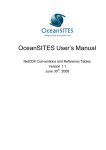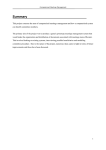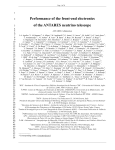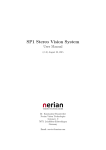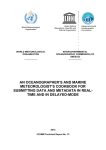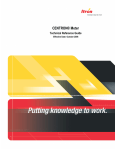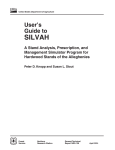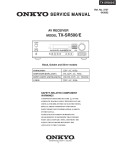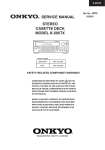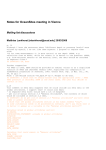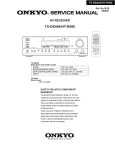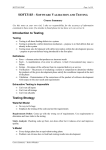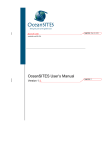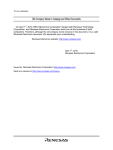Download OceanSITES User`s Manual
Transcript
OceanSITES User’s Manual NetCDF Conventions and Reference Tables Version 1.2 June 29th, 2010 Updated March 21 2013 2 Table of contents OCEANSITES USER’S MANUAL 1 1 6 OCEANSITES DATA-MANAGEMENT PRINCIPLES 1.1 About OceanSITES 6 1.2 About this document 6 1.3 OceanSITES data management structure and data access 6 1.4 User Obligations 6 1.5 Disclaimer 7 1.6 Further Information Sources and Contact Information 7 1.7 Useful links, tools 1.7.1 OceanSITES file format checker 1.7.2 OceanSITES file format converters 7 7 7 2 8 OCEANSITES NETCDF DATA FORMAT VERSION 1.2 2.1 Data file dimensions 8 2.2 Global attributes 9 2.3 Variables 2.3.1 Coordinate variables 2.3.2 Coordinate quality control variables 2.3.3 Data variables 3 OCEANSITES METADATA FORMAT 14 14 16 17 21 3.1 OceanSITES platform information 21 3.2 OceanSITES Parameter and Sensor Information 21 4 REFERENCE TABLES 22 4.1 Reference tables 1: data type and data code 4.1.1 Reference table 1: Data type 22 22 4.2 Reference table 2: Variable quality control flag scale 4.2.1 Reference table 2.1: Overall quality control procedure indicator 4.2.2 Reference table 2.2: cell methods 22 22 23 4.3 Reference table 3: OceanSITES parameter dictionary 4.3.1 Convention for parameter names, standard names and units 4.3.2 References 23 23 24 4.4 Reference table 4: Data Assembly Center Codes 26 4.5 Reference table 5: data mode 26 4.6 Reference table 6: OceanSITES sites catalog 27 4.7 Reference table 7: sensor mount characteristics 27 4.8 Reference table 8: sensor orientation characteristics 28 5 GDAC ORGANIZATION 29 5.1 File naming convention 5.1.1 Data file naming convention 5.1.2 Metadata file naming convention 29 29 30 OceanSITES data management User’s manual 3 5.2 6 Index file for data files GLOSSARY, DEFINITIONS 30 33 6.1 Site 33 6.2 Array 33 6.3 Network 33 6.4 Platform 33 6.5 Deployment 34 6.6 Instrument 34 6.7 Sensor 34 OceanSITES data management User’s manual 4 History Version Date Comment 0.1 20/03/2003 TC: creation of the document 0.3 20/02/2004 TC: updates on locations, mooring name, data state indicator, parameters table, epic codes, history information 0.3.2 26/05/2004 NG: make more flexible, add dataset (metadata) file 0.4 01/06/2004 TC: separate data set description and data file, merge with Steve Hankins’s straw man 0.6 28/06/2004 TC: updates from Nan Galbraith, Steve Hankins, Jonathan Gregory, Brian Eaton 0.7 23/05/2005 Maureen Edwards: NOCS data centre, new GF3 parameters 0.7 24/05/2005 Roy Lowry: physical parameters from BODC Data Markup Vocabulary 1.0 18/02/2006 TC: updates following OceanSITES data management meeting 2006, Hawai’i §2.1: LEVEL dimension replaces DEPTH to accomadate depth or pressure §2.2: QC_MANUAL field created §2.2: CONVENTION field removed §2.2: PLATFORM_CODE added §2.2: SITE_CODE added §2.2: WMO_PLATFORM_CODE added §2.3: DEPTH renamed DEPH to comply to GF3 §2.3: DATA_MODE set at measurement level §3: metadata file description transferred to “OceanSITES metadata proposal” until approval §5: file naming convention updated 1.0 19/02/2006 NG: data codes in chapter 4.1.2 1.0 28/04/2006 PF & NG: data mode optional 1.0 28/04/2006 TC & JG: §2.2 global attributes 1.1 April-MayJune 2008 NG, MM, TC, ML: general revision based on OceanSITES 2008 meeting Epic codes removed Use ISO8601 for string dates Remove general attributes Update global attribute section for CF-1.1 compatibility New dimensions for DEPTH, LATITUDE, LONGITUDE Add an uncertainty attribute New presentation of the document 1.2 draft September 2009 §1.3 : GDAC distribute the “best data” statement §1.4 : add a “User obligations” paragraph §1.5 : add a “Disclaimer” paragraph §2 : note on format version §2.2.1 : no fill value allowed for TIME, LATITUDE, LONGITUDE, DEPTH §2.2.1 : use WGS84 datum for latitude and longitude §2.2.1 : DEPTH “reference” optional attribute §2.2.3 and §4.7 : use “sensor_mount” optional attribute §2.2.3 and §4.8 : use “sensor_orientation” optional attribute §2.2.3 : use sensor_name and sensor_orientation attributes §4.3 : revisit parameter names §4.4 : update DAC codes §4.6 : add a sentence on OceanSITES site naming policy §5.1 : new data file naming convention §5.2: add GDAC_CREATION_DATE, GDAC_UPDATE_DATE, PARAMETERS in the index file. 1.2 draft December th 7 2009 §5.1: revisit file naming convention. §5.2: add a data_mode in the index file. §6: add a “Glossary, definition” chapter. OceanSITES data management User’s manual 5 1.2 draft March 2010 §5.2: add geospatial_vertical_min and geospatial_vertical_min in the index file. §1.7 : useful links chapter created 1.2 draft April 2010 Last comments received from Matthias Lankhorst, Nan Galbraith, Derrick Snowden, Hester Viola, Andrew Dickson, John Graybeal.§1.6: information and contact on project office §2.2.1: update of Z axis §2.2.1: latitude-longitude reference and EPSG coordinate reference §2.2.1: depth EPSG coordinate reference §2.2.1: note on latitude and longitude WGS84 datum §2.2.1: note on DEPTH reference §2.2.3: all attributes listed in the example §2.2.4: metadata variables: sensors information, calibrations §3: simplify metadata introduction §4.2: QC flag scale, 6 not used (comment) §4.3.1: use DOXY_TEMP instead of TEMP_DOXY §4.4: 4 new centres §4.6: update of OceanSITES catalogue 1.2 draft June 2010 Updates from 29/06/2010 webex meeting. §2.1: remove “For a mooring with a GPS receiver, use LATITUDE of the same dimension as TIME and provide the actual location.” §2.2: add an optional “array” and “network” optional global attribute Allow multiple axes in a file §2: remove “Coordinate variables, which describe the dimensions of a data set, are limited to a single set of longitude, latitude, depth and time (X,Y,Z, and T) dimensions in any single file. If data from a reference station cannot all be put on to a single set of axes, then separate files are created for these data.” §2.3.1: remove “Data with different coordinate variables must be recorded in separate files.“ §2.3.1: empty values are not allowed for coordinate variables. 1.2 Feb 1 2013 Clarify requirements for dimensions and coordinates; explain use of (and requirements for use of) ‘coordinates’ attribute in some circumstances. Clarify the statement that QC flag meanings and values are required. OceanSITES data management User’s manual 6 1 OceanSITES data-management principles 1.1 About OceanSITES The OceanSITES program is the global network of open-ocean sustained time series sites, called ocean reference stations, being implemented by an international partnership of researchers. OceanSITES provides fixed-point time series of various physical, biogeochemical, and atmospheric variables at different locations around the globe, from the atmosphere and sea surface to the seafloor. The program’s objective is to build and maintain a multidisciplinary global network for a broad range of research and operational applications including climate, carbon, and ecosystem variability and forecasting and ocean state validation. All OceanSITES data are publicly available. More information about the project is available at: http://www.oceansites.org. 1.2 About this document The main purpose of this document is to specify the format of the files that are used to distribute OceanSITES data, and to document the standards used therein. This includes naming conventions, or taxonomy, as well as metadata content. 1.3 OceanSITES data management structure and data access The data flow within OceanSITES is carried out through three organizational units: PIs, DACs, GDACs. The Principal Investigator (PI), typically a scientist at a research institution, maintains the observing platform and the sensors that deliver the data. He or she is responsible for providing the data and all auxiliary information to a Data Assembly Center (DAC). The DAC assembles OceanSITES-compliant files from this information and delivers these to the two Global Data Assembly Centers (GDACs), where they are made publicly available. The GDAC distributes the best copy of the data files. When a higher quality data file (e.g. calibrated data) is available, it replaces the previous version of the data file. The user can access the data at either GDAC, cf. section “GDAC organization”. Archive of preliminary or real-time data is beyond the scope of the OceanSITES GDACs; this issue should be addressed by the long term archive policy for OceanSITES (under study). 1.4 User Obligations A user of OceanSITES data is expected to read and understand this manual and the documentation about the data as contained in the “attributes” of the NetCDF data files, as these contain essential information about data quality and accuracy. A user of OceanSITES data must comply with the requirements set forth in the attributes “distribution_statement” and “citation” of the NetCDF data files. Unless stated otherwise, a user must acknowledge use of OceanSITES data in all OceanSITES data management User’s manual 7 publications and products where such data are used, preferably with the following standard sentence: “These data were collected and made freely available by the international OceanSITES project and the national programs that contribute to it.” 1.5 Disclaimer OceanSITES data are published without any warranty, express or implied. The user assumes all risk arising from his/her use of OceanSITES data. OceanSITES data are intended to be research-quality and include estimates of data quality and accuracy, but it is possible that these estimates or the data themselves contain errors. It is the sole responsibility of the user to assess if the data are appropriate for his/her use, and to interpret the data, data quality, and data accuracy accordingly. OceanSITES welcomes users to ask questions and report problems to the contact addresses listed in the data files or on the OceanSITES internet page. 1.6 Further Information Sources and Contact Information OceanSITES website: http://www.oceansites.org For further information about the benefits and distributing data onto the GTS, please refer to: http://www.jcommops.org/dbcp/gts or contact the OceanSITES Project Office on [email protected]. For information about unique numbering of OceanSITES Moorings and Gliders on the GTS see: http://www.wmo.int/pages/prog/amp/mmop/wmo-number-rules.html 1.7 Useful links, tools 1.7.1 OceanSITES file format checker The OceansSITES file format checker is a java software freely available at: http://projets.ifremer.fr/coriolis/Observing-the-ocean/Observing-systemnetworks/OceanSITES/Access-to-data 1.7.2 OceanSITES file format converters Medatlas format to OceanSITES NetCDF converter is available at: http://projets.ifremer.fr/coriolis/Observing-the-ocean/Observing-systemnetworks/OceanSITES/Access-to-data ODV format to OceanSITES NetCDF converter is also available at: http://projets.ifremer.fr/coriolis/Observing-the-ocean/Observing-systemnetworks/OceanSITES/Access-to-data OceanSITES data management User’s manual 8 2 OceanSITES NetCDF data format version 1.2 OceanSITES uses the NetCDF (network Common Data Form) system, a set of software libraries and machine-independent data formats. Our implementation of NetCDF is based on the community-supported Climate and Forecast (CF) specification, which supplies a standard vocabulary and some metadata conventions. OceanSITES layers several more conventions above the CF standard.. These are intended to make it easier to share in-situ data, to make it simpler for the GDACs to aggregate data from multiple sites, and to ensure that the data can be created and understood by the basic NetCDF utilities. OceanSITES includes standard terms for the short name of both coordinate and data variables (measurements). File names are created using a standard, described in section 6.2. An OceanSITES data file contains measurements such as temperature and salinity, continuously performed at different levels on a platform (e.g. mooring), as well as meteorological or other parameters recorded at the site, derived variables associated with the site, and complete location, time, and provenance information. The requirements are drawn almost exclusively from the NetCDF Style Guide: Units are compliant with CF/COARDS/Udunits ; The time parameter is encoded as recommended by COARDS and CF. Parameters are given standard names from the CF table Where time is specified as an attribute, the ISO8601 standard is used. For more information on CF, COARDS, NetCDF, Udunits, and ISO8601 see: NetCDF: http://www.unidata.ucar.edu/software/netcdf/docs/BestPractices.html Udunits: http://www.unidata.ucar.edu/software/udunits/ CF: http://cf-pcmdi.llnl.gov/ COARDS: http://www.ferret.noaa.gov/noaa_coop/coop_cdf_profile.html ISO8601: http://en.wikipedia.org/wiki/ISO_8601 Note on format version Since July 2010, the OceanSITES valid data format version is 1.2. The User’s manual may be updated with clarifications, recommendations, additional optional attributes without changing the data format version. 2.1 Data file dimensions NetCDF dimensions provide information on the size of the data variables, and additionally may tie spatial and temporal coordinates to data. OceanSITES time series are limited to a single variable for three of the data dimensions, time, latitude and longitude; multiple depth dimensions are permitted. Requirements are described further in the section on coordinate OceanSITES data management User’s manual 9 variables. Short names for OceanSITES dimension variables should be in upper case. Name Example Comment TIME TIME=unlimited Number of time steps. Example: for a mooring with one value per day and a mission length of one year, TIME contains 365 time steps. DEPTH DEPTH=5 Number of depth levels. Example: for a mooring with measurements at 0.25, 10, 50, 100 and 200 meters, DEPTH=5. LATITUDE LATITUDE=1 Dimension of the LATITUDE coordinate variable. LONGITUDE LONGITUDE=1 Dimension of the LONGITUDE coordinate variable. POSITION POSITION=1 Dimension of the POSITION_QC variable. 2.2 Global attributes The global attribute section of a NetCDF file contains metadata that describes the contents of the file overall, and allows for data discovery. All fields should be human-readable, and should be of character type, not numeric, even if the information content is a number. OceanSITES recommends that all of these attributes be used and contain meaningful information unless there are technical reasons rendering this impossible. However, files that do not at least contain the attributes listed as “mandatory” will not be considered OceanSITES-compliant. In OceanSITES, global attribute names are in lower-case letters. Global attributes can be thought of as conveying five kinds of information: What: what are the data in this dataset; Where: the spatial coverage of the data; When: the temporal coverage of the data; Who: who produced the data; How: how were the data produced and made available. The global attributes specification follows the recommendations of Unidata NetCDF Attribute Convention for Dataset Discovery, at : http://www.unidata.ucar.edu/software/netcdf-java/formats/DataDiscoveryAttConvention.html Name Example Definition WHAT data_type data_type=”OceanSITES time-series data” This field contains the type of data contained in the file. The list of acceptable data types is in reference table 1. Example: “OceanSITES time-series data”. This attribute is mandatory. format_version format_version=”1.1” OceanSITES data management OceanSITES format version Example: “1.1”. This attribute is mandatory. User’s manual 10 platform_code platform_code=”CIS-1” Platform unique code within OceanSITES project. Example: “CIS-1” mooring on CIS site (Central Irminger Sea). This attribute is mandatory. date_update date_update=”2006-04-11T08:35:00Z” File update or creation date (UTC). See note on time format below. This attribute is mandatory. institution institution=”National Oceanographic Centre” Specifies institution where the original data was produced. site_code site_code=”CIS” Name of the site within OceanSITES project. Example: “CIS” for Central Irminger Sea. The site codes are available on GDAC ftp servers. This attribute is mandatory. array array=”TAO” An OceanSITES array is a grouping of sites based on a common and identified scientific question, or on a common geographic location. See the definition in the glossary chapter. network network=”EuroSITES” An OceansSITES network is a grouping of sites based on common shore-based logistics or infrastructure. See the definition in the glossary chapter. wmo_platform_co wmo_platform_code=”48409” de WMO (World Meteorological Organization) identifier. This platform number is unique within the OceanSITES project. Example: “48409” for CIS-1 mooring. source source=”Mooring observation” The method of production of the original data. For OceanSITES data, use one of the following: “Shipborne observation”, “Mooring observation” history history= “2005-04-11T08:35:00Z data collected, A. Meyer. 2005-04-12T10:11:00Z OceanSITES file with provisional data compiled and sent to DAC, A. Meyer.” Provides an audit trail for modifications to the original data. It should contain a separate line for each modification, with each line beginning with a timestamp, and including user name, modification name, and modification arguments. The time stamp should follow the format outlined in the note on time formats below. data_mode data_mode=”R” Indicates if the file contains real-time, provisional or delayed-mode data. The list of valid data modes is in reference table 5. This attribute is mandatory. quality_control_in Quality_control=”6” dicator Level of quality control applied to data. The values are listed in reference table 2.1. quality_index quality_index=”A” references references=”http:// www.oceansites.org, Published or web-based references that http://www.noc.soton.ac.uk/animate/index. describe the data or methods used to produce php” it. Include a reference to OceanSITES and a project-specific reference if appropriate. OceanSITES data management A code value valid for the whole dataset: 0 unknown quality A excellent (no known problems, regular quality checking) B probably good (occasional problems, validation phase) C extremely suspect, frequent problems User’s manual 11 comment comment=”…” Miscellaneous information about the data or methods used to produce it. Any free-format text is appropriate. Conventions Conventions=”CF-1.4, OceanSITES 1.1” Name of the conventions followed by the dataset. “convention” starting in lower case ‘c’ is still valid but will become obsolete. Netcdf_version netcdf_version=”3.5” Netcdf version used for the data set title summary title=”CIS Mooring Data” summary=”Oceanographic mooring data from CIS observatory in the Central Irminger Sea, North Atlantic, in 2005. Measured properties: temperature and salinity at ten depth levels.” Free-format text describing the dataset. The display of these two attributes together should allow data discovery for a human reader. “title”: title of the dataset. Use the file name if in doubt. “summary”: a longer description of the dataset. A paragraph of up to 100 words is appropriate. naming_authority id Naming_authority=”OceanSITES” id=”OS_CIS-1_200502_TS” The “id” and “naming_authority” attributes are intended to provide a globally unique identification for each dataset. For OceanSITES data, use: naming_authority=”OceanSITES” and id=file name (without .nc suffix), which is designed to be unique. cdm_data_type cdm_data_type=”Station” The “cdm_data_type” attribute gives the Unidata CDM (common data model) data type used by THREDDS. E.g. “Point”, “Trajectory”, “Station”, “Radial”, “Grid”, “Swath”. Use “Station” for OceanSITES mooring data. More: http://www.unidata.ucar.edu/projects/THREDD S/CDM/CDM-TDS.htm area=”North Atlantic Ocean” Geographical coverage. Try to compose of the following: North/Tropical/South Atlantic/Pacific/Indian Ocean, Southern Ocean, Arctic Ocean. For specific sea area, use the International Hydrographic Bureau sea areas available at : http://vocab.ndg.nerc.ac.uk/client/vocabServer.j sp. WHERE area geospatial_lat_mi geospatial_lat_min=”59.8” n The southernmost latitude, a value between -90 and 90 degrees. This attribute is mandatory. geospatial_lat_max=”59.8” The northernmost latitude, a value between -90 and 90 degrees. This attribute is mandatory. geospatial_lat_m ax geospatial_lon_m geospatial_lon_min=”-41.2” in The westernmost longitude, a value between 180 and 180 degrees. This attribute is mandatory. geospatial_lon_m geospatial_lon_max=”-41.2” ax The easternmost longitude, a value between 180 and 180 degrees. This attribute is mandatory. geospatial_vertic al_min geospatial_vertical_min=”10.0” Minimum depth for measurements. geospatial_vertic al_max geospatial_vertical_max=”2000” Maximum depth for measurements WHEN OceanSITES data management User’s manual 12 time_coverage_st time_coverage_start=”2006-03art 01T00:00:00Z” Start date of the data in UTC. See note on time format below. time_coverage_e nd Final date of the data in UTC. See note on time format below. time_coverage_end=”2006-0305T23:59:29Z” WHO institution_refere nces institution_references=”http://www.nocs.uk References to data provider institution, the ” place to find all information on the dataset (web-based, i.e. give URLs). contact contact=”[email protected]” Contact person’s e-mail. author author=”John Smith” Name of the person responsible for the creation of the dataset. data_assembly_c data_assembly_center=”EUROSITES” enter Data Assembly Center (DAC) in charge of this data file. The data_assembly_center are listed in reference table 4. pi_name=”Alice Juarez” Name of the principal investigator in charge of the platform. distribution_state ment distribution_statement=”Follows CLIVAR (Climate Varibility and Predictability) standards, cf. http://www.clivar.org/data/data_policy.php. Data available free of charge. User assumes all risk for use of data. User must display citation in any publication or product using data. User must contact PI prior to any commercial use of data.” Statement describing data distribution policy. OceanSITES has adopted the CLIVAR data policy, which explicitly calls for free and unrestricted data exchange. Details at: http://www.clivar.org/data/data_policy.php citation citation=”These data were collected and made freely available by the OceanSITES project and the national programs that contribute to it.” The citation to be used in publications using the dataset. update_interval update_interval=”daily” Update interval for the file, one of the following: “hourly”, “daily”, “yearly”, “void”. Use “void” for delayed-mode or archive data that do not need continuous updating. qc_manual qc_manual=”http://www.ocensites.org/dat a/quality_control_manual.pdf” This field contains the name of the manual that describes the quality control procedure. As of now, there is no separate QC manual, so the user’s manual is the appropriate reference. pi_name HOW Note on time formats Whenever time information is given in the global attributes, it ought to be a string of the format: "YYYY-MM-DDThh:mm:ssZ" (i.e. year - month - day T hour : minute : second Z) If higher resolution than seconds is needed, any number of decimal digits (“.s”) for the seconds is acceptable: OceanSITES data management User’s manual 13 "YYYY-MM-DDThh:mm:ss.sZ" In any case, the time must be in UTC. A capital “T” separates the date and the hour information. The string must end with a capital “Z”, an old indication of UTC. These formats are two (of many) described by ISO8601. Examples: 2005-10-24T08:00:00Z 2008-01-01T22:50:02.031Z OceanSITES data management User’s manual 14 2.3 Variables NetCDF variables include data measured by instruments, parameters derived from the primary measurements, and coordinate variables, which may be nominal values, such as values for depth for instruments that do not directly record depth. The variable names are written in CAPITALIZED letters. Each variable has a specific set of attributes, some of which are mandatory. 2.3.1 Coordinate variables The coordinate variables orient the data in time and space. For this purpose, they have an “axis” attribute defining that they point in X, Y, Z, and T dimensions. The DEPTH variable may be positive in either upward or downward direction, which is defined in its “positive” attribute. Default values are not allowed in coordinate variables. All attributes in this section except the “comment” are mandatory; however “QC_indicator” may be omitted for any parameter if there is a separate QC variable for that parameter. The Z axis may be represented as pressure, if, for example pressure is recorded directly by an instrument and the calculation of depth from pressure would cause a loss of information. Depth is strongly preferred, since it allows data to be used more directly. Type, name, dimension, attributes Comment Double TIME(TIME); TIME:long_name = “time”; TIME:standard_name = “time”; TIME:units = “days since 1950-01-01T00:00:00Z”; TIME:valid_min = 0.0; TIME:valid_max = 90000.0; TIME:QC_indicator = <X>; TIME:QC_procedure = <Y>; TIME:uncertainty = <Z>; TIME:comment = “Optional comment...” TIME:axis = “T”; Date and time (UTC) of the measurement in days since midnight, 1950-01-01. Float LATITUDE(LATITUDE); LATITUDE:long_name = “Latitude of each location”; LATITUDE:standard_name = “latitude”; LATITUDE:units = “degrees_north”; LATITUDE:valid_min = -90.0; LATITUDE:valid_max = 90.0; LATITUDE:QC_indicator = <X>; LATITUDE:QC_procedure= <Y>; LATITUDE:uncertainty = <Z>; LATITUDE:comment = “Optional comment...” LATITUDE:axis=”Y”; LATITUDE:reference="WGS84"; LATITUDE:coordinate_reference_frame="urn:ogc:crs:EPSG::4326"; Latitude of the measurements. Units: degrees north; southern latitudes are negative. OceanSITES data management Example: Noon, Jan 2, 1950 is stored as 1.5. July 25, 2001, 19:14:00 is stored as 18833.8013889885. <X>: Replaces TIME_QC if constant. Cf. note on quality control in data variable section, value from reference table 2. <Y>: Cf. note on quality control in data variable section, value from reference table 2.1. <Z>: Choose appropriate value. Example: 44.4991 for 44° 29’ 56.76’’ N <X>: Replaces POSITION_QC if constant. Cf. note on quality control in data variable section, value from reference table 2. <Y>: Cf. note on quality control in data variable section, value from reference table 2.1. <Z>: Choose appropriate value. User’s manual 15 Float LONGITUDE(LONGITUDE); LONGITUDE:long_name = “Longitude of each location”; LONGITUDE:standard_name = “longitude”; LONGITUDE:units = “degrees_east”; LONGITUDE:valid_min = -180.0; LONGITUDE:valid_max = 180.0; LONGITUDE:QC_indicator = <X>; LONGITUDE:QC_procedure = <Y>; LONGITUDE:uncertainty = <Z>; LONGITUDE:comment = “Optional comment...” LONGITUDE:axis=”X”; LONGITUDE:reference="WGS84"; LONGITUDE:coordinate_reference_frame="urn:ogc:crs:EPSG::4326"; Longitude of the measurements. Unit: degrees east; western latitudes are negative. Float DEPTH(DEPTH); DEPTH:long_name = “Depth of each measurement”; DEPTH:standard_name = “depth”; DEPTH:units = “meters”; DEPTH:positive = “down”; DEPTH:_FillValue = -99999.0; DEPTH:valid_min = 0.0; DEPTH:valid_max = 12000.0; DEPTH:QC_indicator = <X>; DEPTH:QC_procedure = <Y>; DEPTH:uncertainty = <Z>; DEPTH:comment = “Optional comment...” DEPTH:axis=”Z”; DEPTH:reference=<R>; DEPTH:coordinate_reference_frame="urn:ogc:crs:EPSG::5113" Depth of each measurement. Example: 16.7222 for 16° 43’ 19.92’’ E <X>: Replaces POSITION_QC if constant. Cf. note on quality control in data variable section, value from reference table 2. <Y>: Cf. note on quality control in data variable section, value from reference table 2.1. <Z>: Choose appropriate value. Example: 513 for a measurement 513 meters below sea surface. Z axes may be positive=”up” (atmospheric) or positive=”down” (oceanic). <X>: Replaces DEPTH_QC if constant. Cf. note on quality control in data variable section, value from reference table 2. <Y>: Cf. note on quality control in data variable section, value from reference table 2.1. <Z>: Choose appropriate value. <R> : The depth reference default value is “sea_level”. Other possible values are : “mean_sea_level”, “mean_lower_low_water”, “wgs84_geoid” For instruments that do not have fixed depths such as Profiling floats, CTD, gliders, DEPTH is not required; PRES is the vertical axis. Note on latitude and longitude WGS84 datum The latitude and longitude datum is WGS84. This is the default output of GPS systems. OceanSITES uses the EPSG coordinate reference system to describe geographical positions; the coordinate reference frame corresponding to WGS84 is : "urn:ogc:crs:EPSG::5113". More on EPSG : http://www.epsg.org/ Note on DEPTH reference The default depth reference is "sea_level" (free sea surface). In EPSG coordinate reference system, this default reference is: "urn:ogc:crs:EPSG::5113" Note on handling observations in multiple locations An OceanSITES files may contain observations performed in different locations. In that case, the TIME, LATITUDE and LONGITUDE dimensions have the same size. OceanSITES data management User’s manual 16 For example: two CTD casts performed in different locations. TIME, LATITUDE and LONGITUDE dimensions are set to 2 TIME(1) is the time of the first CTD cast, TIME(2) is the time of the second CTD cast LATITUDE(1) is the latitude of the first CTD cast, LATITUDE(2) is the latitude of the second CTD cast LONGITUDE(1) is the longitude of the first CTD cast, LONGITUDE(2) is the longitude of the second CTD cast Note on TIME By default, the time word represents the center of the data sample or averaging period. 2.3.2 Coordinate quality control variables The coordinate variables have the same quality control variables as the data variables. If the quality control values are constant, the information is given in attributes of the coordinate variables. For details, see <PARAM>_QC in the section on data variables, and the note on quality control therein. Type, name, dimension, attributes Comment Byte TIME_QC(TIME); Quality flag for each TIME value. Byte POSITION_QC(POSITION); Quality flag for each LATITUDE and LONGITUDE value. Byte DEPTH_QC(DEPTH); Quality flag for each DEPTH value. OceanSITES data management User’s manual 17 2.3.3 Data variables Data variables contain the actual measurements and indicators about their quality, uncertainty, and mode through which they were obtained. There are different options as to how the indicators are specified, whether in attributes or separate variables, which are outlined in the notes below the table. The variable names are standardized in reference table 3; replace <PARAM> with any of the names indicated there. Mandatory attributes are marked as such, however, OceanSITES requests that all other attributes be used and contain meaningful information unless technical reasons make this impossible. Type, name, dimension, attributes Comment Float <PARAM>(TIME, DEPTH,LATITUDE,LONGITUDE); or Float <PARAM>(TIME, DEPTH); <PARAM>:standard_name = “<X>”; <PARAM>:units = “<Y>”; <PARAM>:_FillValue = <Y>; <PARAM>:coordinates = <’x’>; <PARAM> names are defined in reference table 3. Examples: TEMP, PSAL, DOXY. These 3 attributes are mandatory: standard_name, units and _FillValue. The ‘coordinates’ attribute is REQUIRED when a data variable does not have 4 dimensional coordinate variables in its definition. <PARAM>:long_name = “Y”; <PARAM>:QC_indicator = <X>; <PARAM>:QC_procedure = <X>; <PARAM>:valid_min = <Y>; <PARAM>:valid_max = <Y>; <PARAM>:comment = “<Y>”; <PARAM>:sensor_depth = <Y>; <PARAM>:sensor_mount = <X>; <PARAM>:sensor_orientation = <X>; <PARAM>:sensor_name = <Y>; <PARAM>:sensor_serial_number = <Y>; <PARAM>:ancillary_variables = “<Y>” ; <PARAM>:uncertainty = <Y>; <PARAM>:accuracy = <Y>; <PARAM>:precision = <Y>; <PARAM>:resolution = <Y>; <PARAM>: cell_methods = “<X>”; <PARAM>:DM_indicator = “<X>” <PARAM>:reference_scale = “<Y>” These 11 attributes are highly desirables : QC_indicator, QC_procedure, valid_min, valid_max, sensor_name, uncertainty sensor_serial_number accuracy, precision, resolution, DM_indicator. The other attributes are optional. <X> : standardized attributes listed in reference tables <Y> : attributes whose value is set by the PI (Principal Investigator) standard_name: type char, see reference. table 3 units: type char, see reference table 3 _FillValue: type float, see reference table 3 long_name: type char, free text QC_indicator: type byte, see reference table 2 and note on quality control below QC_procedure type byte, see reference table 2.1 and note on quality control below valid_min: type float. Minimum value for valid data valid_max: type float. Maximum value for valid data comment. type char. Any free-format text with comments as appropriate. sensor_depth. type float. Nominal sensor depth(s) in meters, counting positive as per DEPTH:positive. sensor_mount type char. See reference table 7 for sensor mounting characteristics. sensor_orientation type char. See reference table 8 for sensor orientation characteristics. sensor_name type char (if the data all come from a single sensor). sensor_serial_number type char (if the data all come from a single sensor). OceanSITES data management User’s manual 18 ancillary_variables. type char. Other variables associated with <PARAM>, e.g. <PARAM>_QC. List as space-separated string. Example: TEMP:ancillary_variables=”TEMP_QC TEMP_DM TEMP_UNCERTAINTY” NOTE: no term may appear in the list of ancillary variables that is not the name of a variable in the file. uncertainty: type float. Overall measurement uncertainty, if constant. Cf. note on uncertainty below. accuracy: type float. Nominal sensor accuracy. Cf. note on uncertainty below. precision: type float. Nominal sensor precision. Cf. note on uncertainty below. resolution: type float. Nominal resolution of this data parameter. cell_methods: type char. Specifies cell method as per CF convention. Example: TEMP:cell_methods=”TIME: point DEPTH: point LATITUDE: point LONGITUDE: point” Values are listed in table 2.2 DM_indicator: Type char. Data mode, if constant, as per reference table 5. Cf. note on data modes below. reference_scale: type char. For some measurements that are provided according to a standard reference scale specify the the reference scale with this optional attribute. Example: ITS-90, PSS-78 Byte <PARAM>_QC(TIME, DEPTH); <PARAM>_QC:flag_values = 0, 1, 2, 3, 4, 5, 7, 8, 9; <PARAM>_QC:flag_meanings = “no_qc_performed good_data probably_good_data bad_data_that_are_potentially_correctabl e bad_data value_changed nominal_value interpolated_value missing_value” <PARAM>_QC:long_name = “quality flag”; <PARAM>_QC:conventions = “OceanSITES reference table 2”; <PARAM>_QC:_FillValue = -128; <PARAM>_QC:valid_min = 0; <PARAM>_QC:valid_max= 9; Quality flags for values of associated <PARAM>. flag_values: type byte. Required; fixed value flag_meanings: type char. Required; fixed value Char <PARAM>_DM(TIME, DEPTH); <PARAM>_DM:long_name = “method of data processing “; <PARAM>_DM:conventions = “ OceanSITES reference table 5”; <PARAM>_DM:flag_values = “R”, “P”, “D”, “M”; <PARAM>_DM:flag_meanings = “realtime provisional delayed-mode mixed”; <PARAM>_DM:_FillValue = “ “; This is the data mode. Indicates if the data point is real-time, delayed-mode or provisional mode. It is included when the dataset mixes modes for a single variable. See note on data modes below, and reference table 5. long_name: type char. Required; fixed value conventions: type char. Required; fixed value flag_values: type char. Required; fixed value flag_meanings: type char. Required; fixed value _FillValue: type char. Required; fixed value Float <PARAM>_UNCERTAINTY(TIME, DEPTH): <PARAM>_UNCERTAINTY:long_name = “uncertainty” <PARAM>_UNCERTAINTY:_FillValue=< Y> <PARAM>:units = “<Y>”; Overall uncertainty of the data given in <PARAM>. See note on uncertainty below. long_name: type char. Required; fixed value _FillValue: type float. Required. units: type char. Required. Must be the same as <PARAM>:units. The flag scale is specified in reference table 2, and is included in the flag_meanings attribute. long_name: type char. fixed value conventions. type char. Required; fixed value _FillValue. type byte. Required; fixed value valid_min. type byte. Required; fixed value valid_max: type byte. Required; fixed value Note on ‘coordinates’ attribute: OceanSITES data management User’s manual 19 All of a variable's spatiotemporal coordinates (latitude, longitude, vertical, and time) that are not dimensions of the variable (e.g. Float <PARAM>(TIME, DEPTH); as opposed to Float <PARAM>(TIME, DEPTH, LATITUDE, LONGITUDE); are required to be associated with the data variable via the ‘coordinates’ attribute of the variable. The value of the coordinates attribute is a blank separated list of the names of auxiliary coordinate variables. Note on quality control (QC) The quality of the data in a variable <PARAM> is described by the attribute <PARAM>:QC_procedure, and one of the following: the attribute <PARAM>:QC_indicator or the variable <PARAM_QC>. <PARAM>:QC_procedure is mandatory and contains values from reference table 2.1, which describe what kind of quality control procedure has been applied. It is mandatory to define one of <PARAM>:QC_indicator or <PARAM_QC>, both of which would contain values describing the data quality as per reference table 2. If the quality is the same for all <PARAM>, use <PARAM>:QC_indicator. Else, use <PARAM_QC>. Note on uncertainty If the overall measurement uncertainty for a variable <PARAM> is reasonably well-known, it must be provided in the attribute <PARAM>:uncertainty if it is constant, or in a variable of its own, <PARAM>_UNCERTAINTY, if it is not constant. If uncertainty is given in either way, the attribute <PARAM>:accuracy is optional. If it is impossible to estimate the overall measurement uncertainty, it is required to define at least the attribute <PARAM>:accuracy with the nominal sensor accuracy. The attributes <PARAM>:precision and <PARAM>:resolution are optional; they contain the sensor precision and resolution if defined. Note on data modes (DM) Data mode may be represented as a global attribute “data_mode” if all data is a single mode, or as an attribute to a variable <PARAM>:DM_indicator if all data for <PARAM> is in a single mode. If a parameter contains a mixture of modes, these attributes should be set to “M” and the actual data modes should be represented by an extra variable, <PARAM>_DM. The values for the data modes are explained in reference table 5. Example for sea temperature measurements and associated quality flags Float TEMP(TIME, DEPTH); TEMP:standard_name = “sea_water_temperature”; TEMP:units = “degree_Celsius”; TEMP:_FillValue = 99999.f; TEMP:long_name = “sea water temperature in-situ ITS-90 scale”; TEMP:QC_indicator = 1; TEMP:QC_procedure = 5; TEMP:valid_min = -2.0f; TEMP:valid_max = 40.f; TEMP:comment = “”; TEMP:sensor_depth = 1; TEMP:sensor_mount = "mounted_on_surface_buoy"; TEMP:sensor_name = "SBE41"; TEMP:sensor_serial_number = "3263"; TEMP:ancillary_variables = “TEMP_QC” ; TEMP:uncertainty = 0.01f; OceanSITES data management User’s manual 20 TEMP:accuracy = 0.01f; TEMP:precision = 0.01f; TEMP:resolution = 0.001f; TEMP:cell_methods=”median”; TEMP:DM_indicator=”P”; TEMP:reference_scale = “ITS-90”; TEMP_QC:long_name = “quality flag”; TEMP_QC:conventions = “OceanSITES reference table 2”; TEMP_QC:_FillValue = -128; TEMP_QC:flag_values = 0, 1, 2, 3, 4, 5, 7, 8, 9; TEMP_QC:flag_meanings = “no_qc_performed good_data probably_good_data bad_data_that_are_potentially_correctable bad_data value_changed nominal_value interpolated_value missing_value” OceanSITES data management User’s manual 21 3 OceanSITES metadata format OceanSITES is developing an OGC SensorML metadata file format. Meanwhile, this information is available in a Microsoft Word file, a text file, or a modified CDL (NetCDF output) file. 3.1 OceanSITES platform information Name Value Required/ Optional platform_category Air-Sea Flux Site, Transport Site, Physical, Meteorological, Biogeochemical, Geophysical Required wmo_message_format WMO standard formats: FM13, FM18, FM64, or FM65. PIs may request desired WMO formats and GDAC will determine the final formats to be used WMO standard uses wind-from-direction, indicate if the real-time wind direction received by GDAC/DAC is a wind-to-direction before GTS dissemination. The frequency of message reporting from buoy to DAC, such as daily, hourly, or every 10min etc.) Optional wind_direction_conventions platform_message_reporting_frequency Optional Required 3.2 OceanSITES Parameter and Sensor Information This section is to be used by PI to provide parameter and associated sensor information for each of the platform dataset files specified in section 2. If real-time GPS tracking data are available, use LATITUDE and LONGITUDE as the position parameters. Please use one form for each parameter. Name Value Required Optional parameter_name OS 1.1 parameter - valid parameter name in OceanSITES parameter dictionary as netCDF variable name Example : TEMP Name of the sensor vendor Example : PMEL Required Period(s) in minutes when sampling occurs in one message report from buoys, typically in one hour Example : Instantaneous Instantaneous or frequency in HZ or every 15 second etc Example : 1 per 10 min UTC time represents middle, beginning, or end of sampling periods, indicate if sensor reporting time differs from the corresponding platform message reporting time Example: Sensor reports at the top of the hour and every ten minutes after. Data is transmitted once daily as a mean. Desired sensor_vendor sensor_sampling_period sensor_sampling_frequency sensor_reporting_time OceanSITES data management Desired Desired Optional User’s manual 22 4 Reference tables 4.1 Reference tables 1: data type and data code 4.1.1 Reference table 1: Data type The data_type global attribute should have one of the valid values listed here. Data type OceanSITES metadata OceanSITES profile data OceanSITES time-series data OceanSITES trajectory data 4.2 Reference table 2: Variable quality control flag scale The quality control flags indicate the data quality of the data values in a file, and are normally assigned after quality control procedures have been performed. These codes are used in the <PARAM>_QC variables to describe the quality of each measurement, or in the attribute <PARAM>:QC_indicator to describe the overall quality of the parameter. Code Meaning Comment 0 No QC was performed - 1 Good data All QC tests passed. 2 Probably good data - 3 Bad data that are potentially correctable These data are not to be used without scientific correction or recalibration. 4 Bad data Data have failed one or more tests. 5 Value changed Data may be recovered after transmission error. 6 - Not used. 7 Nominal value Data were not observed but reported. Example: an instrument target depth. 8 Interpolated value Missing data may be interpolated from neighboring data in space or time. 9 Missing value - 4.2.1 Reference table 2.1: Overall quality control procedure indicator This table describes the quality procedures applied to all the measurement of a parameter. These values are used as an overall quality indicator (i.e. one summarizing all measurements) in the attributes of each variable <PARAM>. Cf. <PARAM>:QC_procedure attribute description in section 3.2.3. Code Meaning 0 No QC performed OceanSITES data management User’s manual 23 1 Ranges applied, bad data flagged 2 Data interpolated 3 Sensor malfunctioning (data possibly useful) 4 Data missing 5 Data manually reviewed 6 Data verified against model or other contextual information 7 Other QC process applied 4.2.2 Reference table 2.2: cell methods From NetCDF Climate and Forecast (CF) Metadata Conventions, Version 1.2, 4 May, 2008. In the Units column, u indicates the units of the physical quantity before the method is applied. Cell Method Units Description point u The data values are representative of points in space or time (instantaneous). sum u The data values are representative of a sum or accumulation over the cell. maximum u Maximum median u Median mid_range u Average of maximum and minimum minimum u Minimum mean u Mean (average value) mode u Mode (most common value) standard_deviation u Standard deviation variance Variance u2 4.3 Reference table 3: OceanSITES parameter dictionary 4.3.1 Convention for parameter names, standard names and units The parameter dictionary is is available on GDACs ftp servers. Parameter names should start with a code based on SeaDataNet-BODC parameter discovery vocabulary. They are not strictly standardized, however. When necessary, a parameter name has a suffix that designates secondary parameters1. The suffix starts with the character “_”. u OceanSITES data management User’s manual 24 The NetCDF “standard_name” attribute contains the standardized parameter name from CF conventions. The NetCDF “units” attribute are compliant with Udunits as implemented in the CF/COARDS standards. As the parameter names are not strictly standardized, one should use the standard_name attribute to query a particular measurement from different data files. Example On a mooring, sea temperature measured by a series of Microcat CTD is reported as TEMP, with a standard name of SEA_WATER_TEMPERATURE. Secondary temperature measurement performed by an oxygen sensor is reported as DOXY_TEMP with a standard name of temperature_of_sensor_for_oxygen_in_sea_water. For both measurements, the unit attribute is “degree_Celsius”. 4.3.2 References The OceanSITES standard names are taken from the CF standard names, available at: http://cf-pcmdi.llnl.gov/documents/cf-standard-names/ The parameter names are based on SeaDataNet-BODC parameter discovery vocabulary available at: http://seadatanet.maris2.nl/v_bodc_vocab/welcome.aspx Select P021, “ BODC Parameter Discovery Vocabulary” The units are compliant with Udunits, as implemented by the CF standard; definitions are available at: http://www.unidata.ucar.edu/software/udunits The valid parameter names, standard names are available on GDACs ftp servers. OceanSITES data management User’s manual 25 The following list an extract of the OceanSITES parameter dictionary for parameter name and standard name. Parameter Standard name AIRT air_temperature ATMP air_pressure ATMS air_pressure_at_sea_level CDIR direction_of_sea_water_velocity was sea_water_direction CNDC sea_water_electrical_conductivity CSPD sea_water_speed DEPTH depth DEWT dew_point_temperature DOX2 moles_of_oxygen_per_unit_mass_in_sea_water was dissolved_oxygen DOXY mass_concentration_of_oxygen_in_sea_water was dissolved_oxygen DOXY_TEMP temperature_of_sensor_for_oxygen_in_sea_water DRYT dry_bulb_temperature DYNHT dynamic_height EWCT eastward_sea_water_velocity FLU2 fluorescence HCSP sea_water_speed HEAT heat_content ISO17 isotherm_depth LW surface_downwelling_longwave_flux_in_air NSCT northward_sea_water_velocity OPBS optical_backscattering_coefficient PCO2 surface_partial_pressure_of_carbon_dioxide_in_air was CO2_partial_pressure_in_dry/wet_gas PRES sea_water_pressure PSAL sea_water_salinity RAIN rainfall_rate RAIT thickness_of_rainfall_amount RELH relative_humidity SDFA surface_downwelling_shortwave_flux_in_air SRAD isotropic_shortwave_radiance_in_air SW surface_downwelling_shortwave_flux_in_air TEMP sea_water_temperature UCUR eastward_sea_water_velocity UWND eastward_wind OceanSITES data management User’s manual 26 VAVH sea_surface_wave_significant_height VAVT sea_surface_wave_zero_upcrossing_period VCUR northward_sea_water_velocity VDEN sea_surface_wave_variance_spectral_density VDIR sea_surface_wave_from_direction VWND northward_wind WDIR wind_to_direction WSPD wind_speed 4.4 Reference table 4: Data Assembly Center Codes Data Assembly Centers and institutions BERGEN UNIVERSITY OF BERGEN GEOPHYSICAL INSTITUTE CCHDO CLIVAR and Carbon Hydographic Office CDIAC CARBON DIOXIDE INFORMATION ANALYSIS CENTER EUROSITES EuroSites EU project IMOS AUSTRALIAN INTEGRATED MARINE OBSERVING SYSTEM INCOIS Indian National Centre for Ocean Information Services JAMSTEC Jamstec, Japan MBARI Monterey Bay Aquarium Research Institute MEDS MEDS, Canada NDBC National Data Buoy Center, USA NIOZ ROYAL NETHERLANDS INSTITUTE FOR SEA RESEARCH NOCS National Oceanography Centre, Southampton PMEL PMEL, USA SIO SIO, Scripps, USA WHOI Woods Hole Oceanographic Institution, USA 4.5 Reference table 5: data mode The values for the variables “<PARAM>_DM”, the global attribute “data_mode”, and variable attributes “<PARAM>:DM_indicator” are defined as follows: Value Meaning R Real-time data. Data coming from the (typically remote) platform through a communication channel without physical access to the instruments, disassembly or recovery of the platform. Example: for a mooring with a radio communication, this would be data obtained through the radio. P Provisional data. Data obtained after the instruments or the platform have been recovered or serviced. Example: for instruments on a mooring, this would be data downloaded directly from the instruments after the mooring has been recovered on a ship. D Delayed-mode data. Data published after all calibrations and quality control procedures have been applied on the internally recorded or best available original data. This is the best possible version of processed data. OceanSITES data management User’s manual 27 M Mixed. This value is only allowed in the global attribute “data_mode” or in attributes to variables in the form “<PARAM>:DM_indicator”. It indicates that the file contains data in more than one of the above states. In this case, the variable(s) <PARAM>_DM specify which data is in which data mode. 4.6 Reference table 6: OceanSITES sites catalog The OceanSITES catalogue is managed by the Project Office (email: [email protected]). An OceanSITES site and platforms have unique names provided by OceanSITES Project Office after agreement from the Principal Investigator and the OceanSITES Steering Team The Project Office ensures that platform_codes are unique among OceanSITES. The WMO codes are requested to WMO by the DAC or the national contact with WMO. The OceanSITES sites catalogue will be made available on GDACs ftp servers. The following list is an extract from the catalogue. 4.7 Reference table 7: sensor mount characteristics The <PARAM>:”sensor_mount” attribute indicates the way a sensor is mounted on a mooring. The following table lists the valid sensor_mount attribute values. sensor_mount mounted_on_fixed_structure mounted_on_surface_buoy OceanSITES data management User’s manual 28 mounted_on_mooring_line mounted_on_bottom_lander mounted_on_moored_profiler mounted_on_glider mounted_on_shipborne_fixed mounted_on_shipborne_profiler mounted_on_seafloor_structure mounted_on_benthic_node mounted_on_benthic_crawler mounted_on_surface_buoy_tether mounted_on_seafloor_structure_riser mounted_on_fixed_subsurface_vertical_profiler 4.8 Reference table 8: sensor orientation characteristics When appropriate, the <PARAM>:”sensor_orientation” attribute indicates the way a sensor is oriented on a mooring. The following table lists the valid sensor_orientation attribute values. sensor_orientation comment downward Example : ADCP measuring from surface to bottom currents. upward Example : In-line ADCP measuring currents towards the surface vertical - horizontal - OceanSITES data management User’s manual 29 5 GDAC organization There are two GDACs (global data assembly centers) for redundancy, which are the users’ access points for OceanSITES data. One GDAC is located in France (Coriolis, http://www.coriolis.eu.org), the other one in the USA (NDBC, National Data Buoy Center, http://www.ndbc.noaa.gov). The GDACs handle OceanSITES data, metadata, and index files on ftp servers. The servers at both GDACs are synchronized at least daily to provide the same OceanSITES data. The user can access the data at either GDAC’s ftp site: ftp://data.ndbc.noaa.gov/data/oceansites ftp://ftp.ifremer.fr/ifremer/oceansites From these root directories of the GDACs downward, the organization of the directories and files is: DATA/site/FileName.nc site: OceanSITES site code The sites codes will be listed in the “OceanSITES catalogue” document at either GDAC’s root directory. 5.1 File naming convention The OceanSITES file names use the following naming convention for data and metadata files. 5.1.1 Data file naming convention OS_XXX_YYY_T_PARTX.nc OS - OceanSITES prefix XXX - Platform code from the OceanSITES catalogue YYY - Deployment code (unique code for deployment - date or number) T - Data Mode o R: real-time data o P : provisional data o D: delayed mode o M: mixed delayed mode and real-time. <_PARTX> - An optional user defined field for identification of data Example OS_CIS-1_200905_R_CTD.nc This file contains temperature and salinity data from the CIS-1 mooring, from the EuroSITES project, for the deployment performed in May 2009. OceanSITES data management User’s manual 30 5.1.2 Metadata file naming convention OS_XXX_YYY_META.zzz OS: OceanSITES prefix XXX: platform code YYY: deployment code zzz: metadata file suffix (.txt, .doc, .xml) These metadata are for the corresponding data file(s) OS_XXX_YYY_T_ZZZ_PARTX.nc Example OS_CIS-1_200905_META.xml This file contains the metadata of CIS-1 mooring, for the deployment performed in May 2009. 5.2 Index file for data files To allow for data discovery without downloading the data files themselves, an index file is created at the GDAC level, which lists all available data files and the location and time ranges of their data contents: The data index file is located at the root directory of the GDAC. The index file contains the list and a description of all data files available on the GDAC. There is a header section, lines of which start with # characters. The information sections are comma-separated values. Each line contains the following information: file: the file name, beginning from the GDAC root directory date_update: the update date of the file, YYYY-MM-DDTHH:MI:SSZ start_date: first date for observations, YYYY-MM-DDTHH:MI:SSZ end_date: last date for observations, YYYY-MM-DDTHH:MI:SSZ southern_most_latitude northern_most_latitude western_most_longitude eastern_most_longitude geospatial_vertical_min geospatial_vertical_min update_interval: M monthly, D daily, Y yearly, V void size: the size of the file in megabytes gdac_creation_date: date of creation of the file on the GDAC gdac_update_date: date of update of the file on the GDAC. data_mode: R, P, D, M (real-time, provisional, delayed mode, mixed; see reference table 5) parameters: list of parameters (standard_name) available in the file separated with OceanSITES data management User’s manual 31 blank The fill value is empty: ",,". OceanSITES data management User’s manual 32 GDAC data files index: oceansites_files_index.txt # OceanSites FTP GLOBAL INDEX # FTP://FTP.IFREMER.FR/IFREMER/OCEANSITES # Contact: HTTP://WWW .OCEANSITES.ORG # Index update date YYYY-MM-DDTHH:MI:SSZ: 2008-03-30T18:37:46Z # #file,date_update,start_date,end_date, southern_most_latitude,northern_most_latitude,western_most_longitude,eastern_most_longitude, geospatial_vertical_min,geospatial_vertical_min,update_interval,size,gdac_creation_date,gdac_update_date,d ata_mode,parameters TAO/0n170w/OS_0n170w_SW_LW_2m.nc,2008-04-12T08:05:00Z,2007-03-17T18:07:00Z,2008-0412T08:05:00Z,0,0,-170,-170,M,16.7,0,550,2008-04-12T08:05:00Z,2008-0412T08:05:00Z,R,sea_water_pressure sea_water_temperature sea_water_salinity OceanSITES data management User’s manual 33 6 Glossary, definitions This chapter gives a definition for the OceanSITES items described in this manual. 6.1 Site An OceanSITES site is a defined geographic location where sustained oceanographic, meteorological or other observations are made. Example: CIS is a site in the Central Irminger Sea. Note: A site should be thought of as a point in space, i.e. a nominal position, with a small area extent around it, such that successive observations from anywhere within this area reasonably represent conditions at the nominal position for the major scientific questions that the observations address. 6.2 Array An OceanSITES array is a grouping of sites based on a common and identified scientific question, or on a common geographic location. Example: An IRMINGERSEA array would identify the sites CIS, LOCO-IRMINGERSEA, and OOI-IRMINGERSEA as sharing a common scientific interest and/or geographic location. Notes: It is valid for a single site to belong to no, one, or multiple arrays. Documenting the array is recommended only if it identifies commonalities beyond a single project or a single operating institution. 6.3 Network An OceansSITES network is a grouping of sites based on common shore-based logistics or infrastructure. Example: EuroSITES, although technically a single project, bundles multiple institutional efforts and connects otherwise remote sites to a degree that warrants calling it a network. Notes: It is valid for a single site to belong to no, one, or multiple networks. Documenting the network is recommended only if it identifies structures beyond a single project or a single operating institution. 6.4 Platform An OceanSITES platform is an independently deployable package of instruments and sensors forming part of site. It may be fixed to the ocean floor, may float or may be self-propelled. Examples: CIS-1: a mooring in Central Irminger Sea THETYS II: a vessel that performs regular CTDs at DYFAMED site. OceanSITES data management User’s manual 34 6.5 Deployment An OceanSITES deployment is an instrumented platform performing observations for a period of time. Changes to the instrumentation or to the spatial characteristics of the platform or its instruments constitute the end of the deployment. Examples: The CTD data for CIS-1 deployment performed in May 2009 (200905) and are distributed as OS_CIS-1_200905_R_CTD.nc file. 6.6 Instrument An OceanSITES instrument is device that provides digital data output. Examples: CTD, ADCP, Meteorological Package. 6.7 Sensor A device that measures environmental parameter but does not digitize data for transmission, it needs to be connected to an instrument to produce a data stream that a computer can read. Examples: Transmissiometer, Fluorometer, Oxygen sensor. OceanSITES data management User’s manual


































